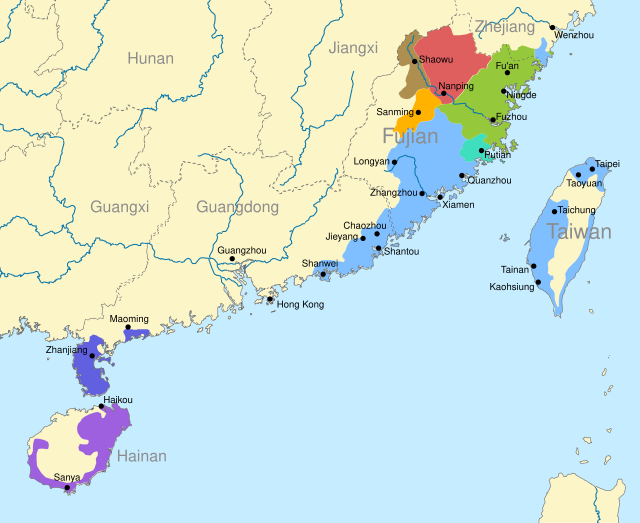Top Qs
Timeline
Chat
Perspective
Hainanese
Min Chinese dialects spoken on the island of Hainan From Wikipedia, the free encyclopedia
Remove ads
Hainanese or Hainamese (Hainan Romanised: Hái-nâm-oe, Hainanese Pinyin: Hhai3 nam2 ue1, simplified Chinese: 海南话; traditional Chinese: 海南話; pinyin: Hǎinánhuà), also known as Kengbun/Kengvun (simplified Chinese: 琼文话; traditional Chinese: 瓊文話), Keng language (琼语; 瓊語) or Hainam Min (海南闽语; 海南閩語) [5] is a language of Min Chinese spoken in the island of Hainan and regional overseas Chinese communities in Thailand especially.
This article needs additional citations for verification. (January 2015) |

In the classification by Yuan Jiahua, it was added to the Southern Min group by Him despite being mutually unintelligible with Southern Min varieties such as Hokkien and Teochew.[6] In the classification of Li Rong, used by the Language Atlas of China, it was treated as a separate Min subgroup.[7] Hou Jingyi combined it with Leizhou Min, spoken on the Leizhou Peninsula, in a Qiong–Lei group.[8] "Hainanese" is also used for the language of the Li people living in Hainan, but generally refers to Min varieties spoken in Hainan.
Remove ads
Phonology
Summarize
Perspective
The phonologies of the different varieties of Hainanese are highly divergent,[9] with the Wenchang dialect being the prestige dialect, and often used as a reference.[10]
Consonants
Below is a table for the consonants of Hainanese across the dialects of Wenchang, Haikou and the dialect of Banqiao Town, in Dongfang.[9] For more information on a specific variety, please consult the relevant article.
- Present in the Banqiao dialect.
- Present in the Haikou dialect.
- Present in the Wenchang dialect, where there is a phonemic distinction between voiced and implosive stop consonants.
- Present in the Wenchang dialect.
- Not usually transcribed as /ɠ/, and not phonemically distinct from /g/ in the Wenchang dialect or from /ŋ/ in other Hainanese varieties.[11]
Many of the most widely spoken varieties of Hainanese notably have a series of implosive consonants, /ɓ/ and /ɗ/, which were acquired through contact with surrounding languages, probably Hlai. However, more conservative varieties of Hainanese such as Banqiao remain closer to Leizhou Peninsula Min and other varieties, lack them.[9]
The consonant system of Hainanese corresponds well with that of Leizhou Peninsula Min, but it has had some restructuring. In particular:[9]
- Etymological plain stops have undergone implosivization (*p > [ɓ], *t > [ɗ]) in the more innovative varieties such as Wenchang and Haikou.
- Etymological aspirated stops have spirantized (*pʰ > [ɸ], *tʰ > [h], *tsʰ > [ɕ], *kʰ > [h~x]) in more innovative varieties.
- The lenition of an historic *b into [v] in Banqiao and Haikou, though not in Wenchang.
- Former *s has hardened into a stop (*s > [t]), although in the more conservative Banqiao dialect some instances have only undergone fortition to (*s > [θ]), and others have remained [s].
- Former *h has become [ɦ] in Wenchang.
Additionally, [ʑ] is an allophone of /j/.
These changes also make Hainanese fairly close to Sino-Vietnamese vocabulary.
Vowels
Hainanese has seven phonemic vowels.[citation needed]
Tones
Remove ads
Romanization
Hainanese Pinyin
Hainanese Pinyin (海南话拼音方案) is a phonetic system announced by the Education Administration Department of Guangdong Province in September 1960. It marks tones with numbers.
Initials
Finals
Remove ads
Grammar
Hainanese is known for having post-verbal locative prepositional phrases,[12] as opposed to having such phrases in the pre-verbal position, as is common in most other varieties of Chinese. For example:
伊
ʔi24
3SG
大聲
ɗua24 tia24
loudly
啼
hi21
cry
佇
ɗu33
in
房裡
ɓaŋ21-lɛ33
room-LOC
(Haikou)
He was crying loudly in the room.
This has been attributed to contact with the Kra–Dai languages of Hainan, such as Hlai and Be.[12]
See also
- Hainanese culture
- Hainanese people
Notes
References
Further reading
External links
Wikiwand - on
Seamless Wikipedia browsing. On steroids.
Remove ads


